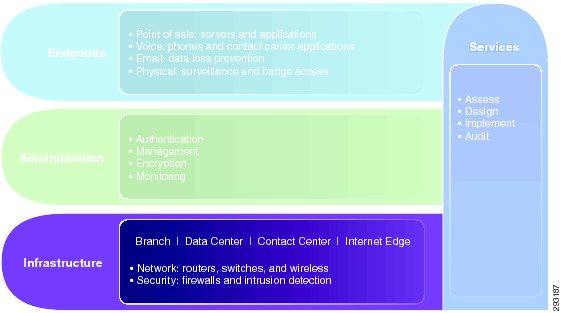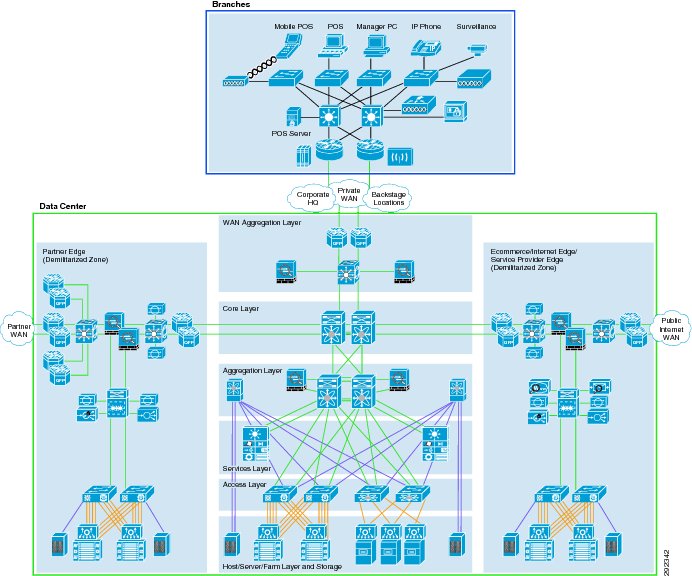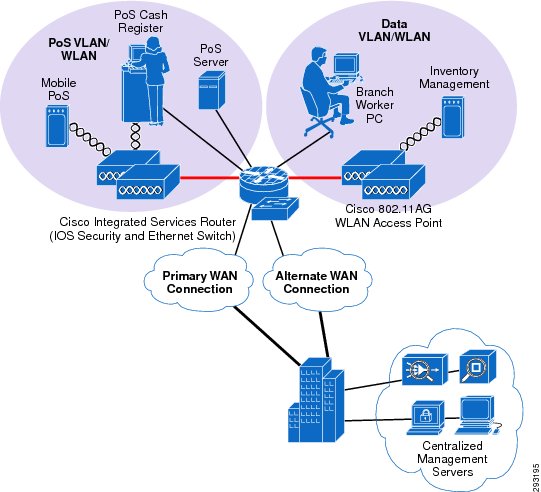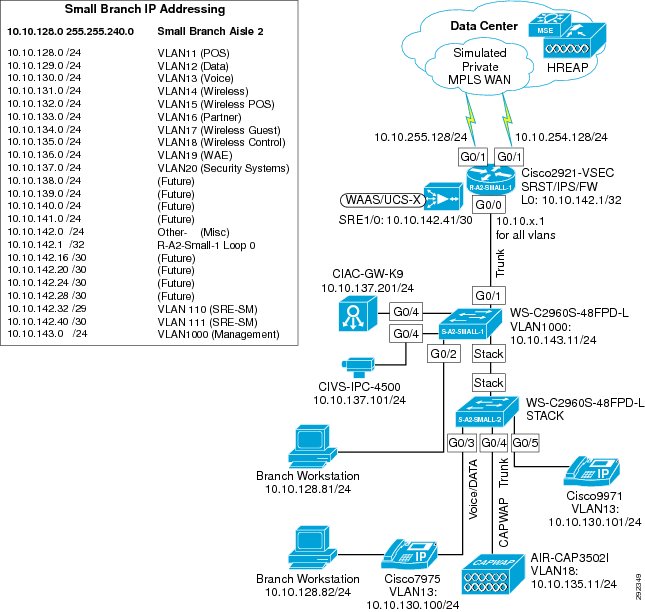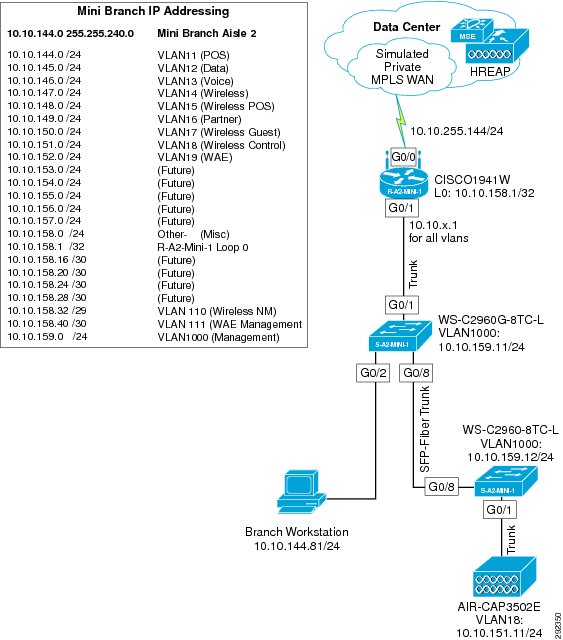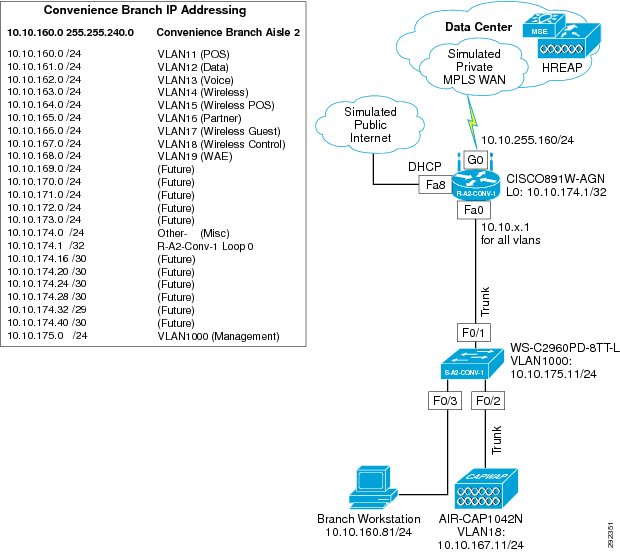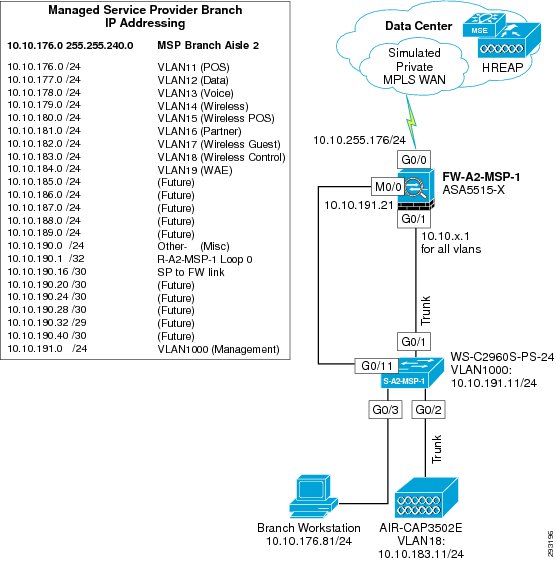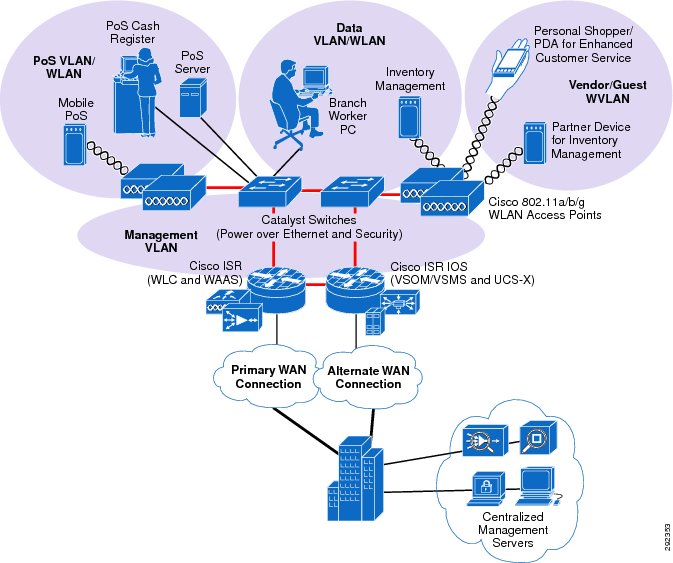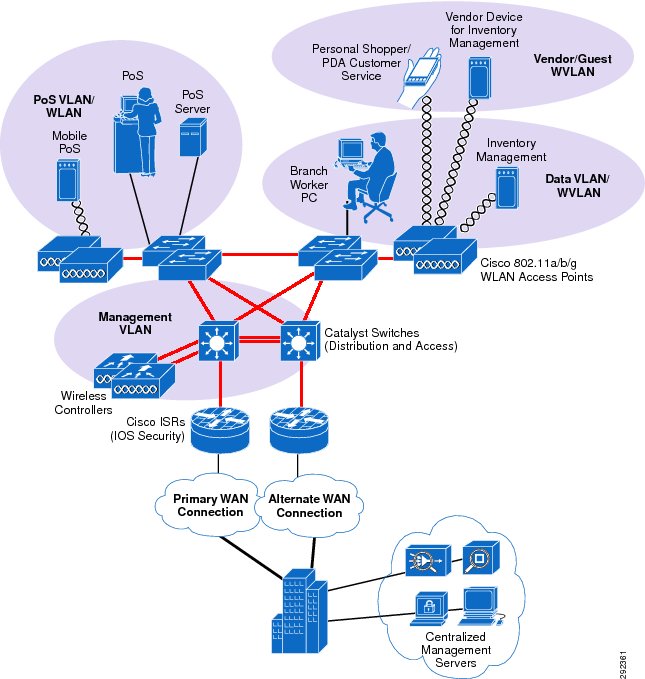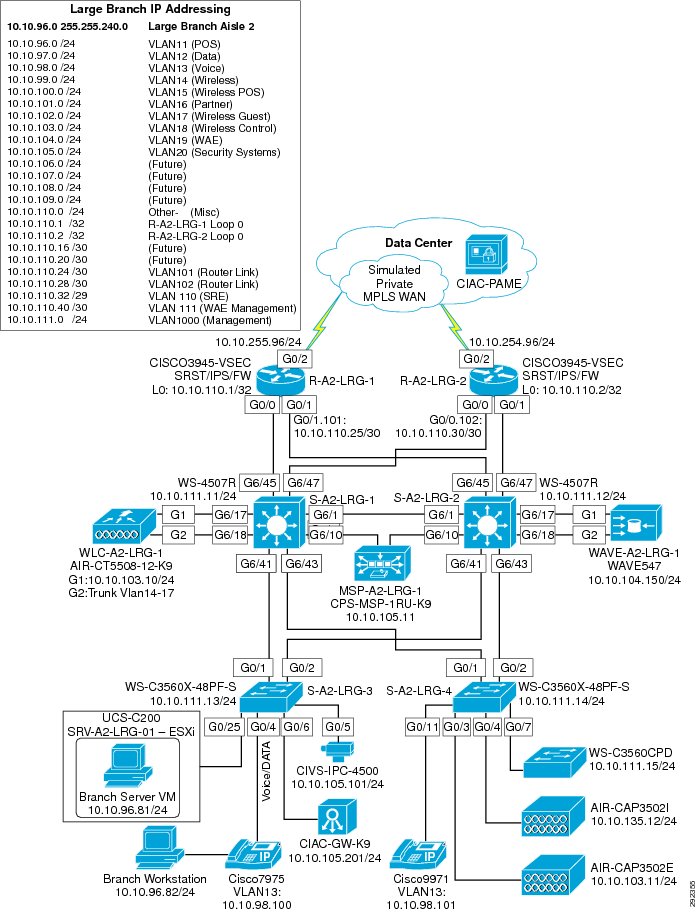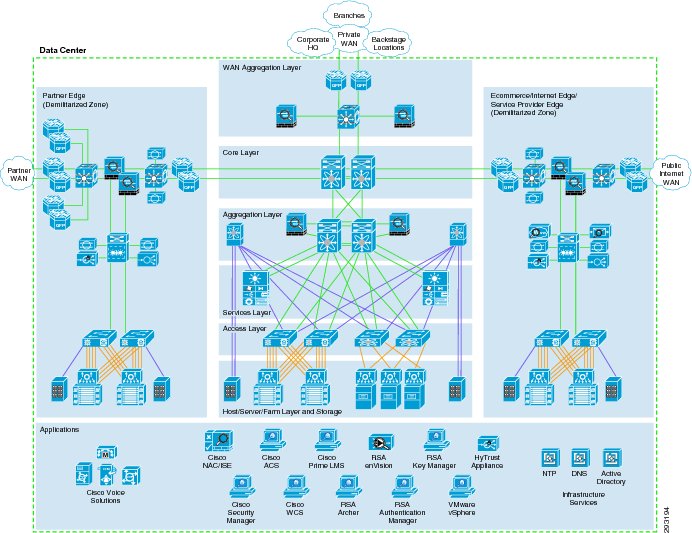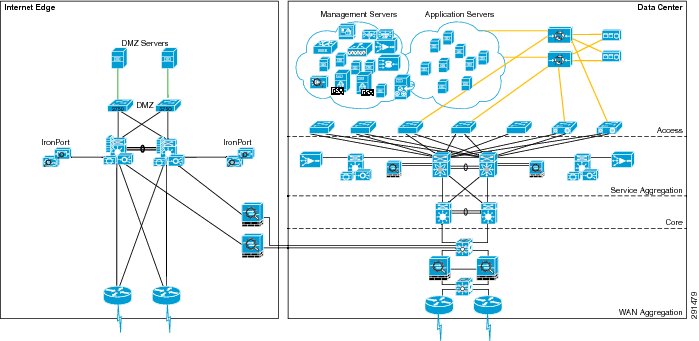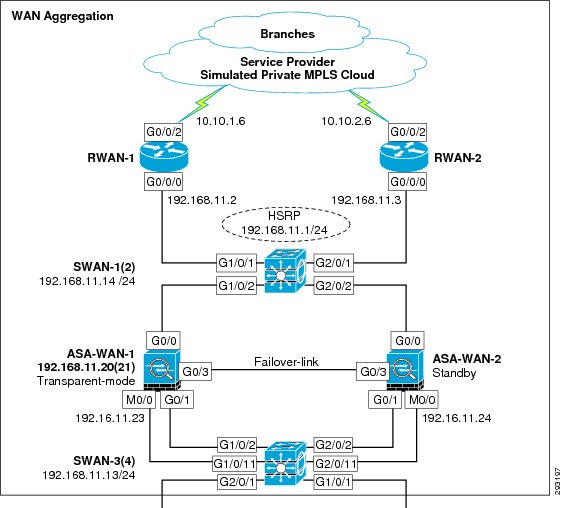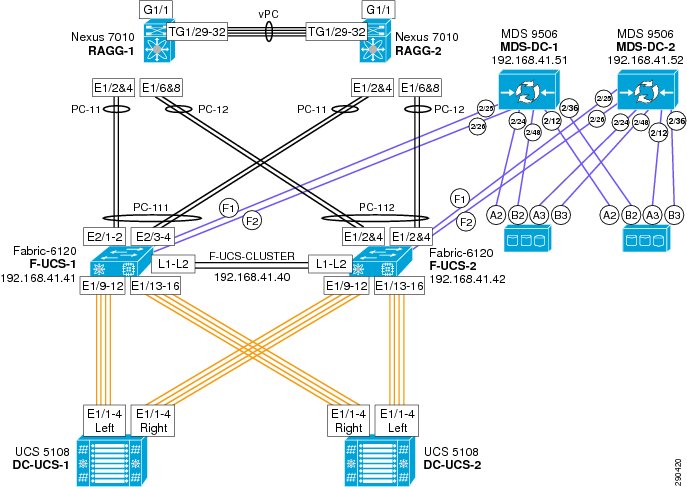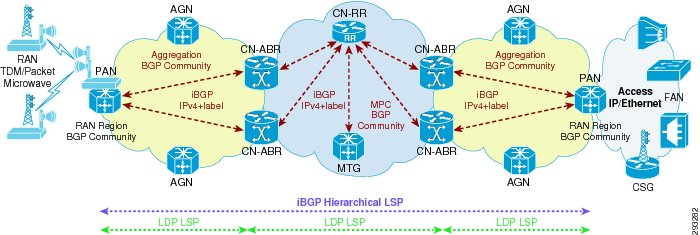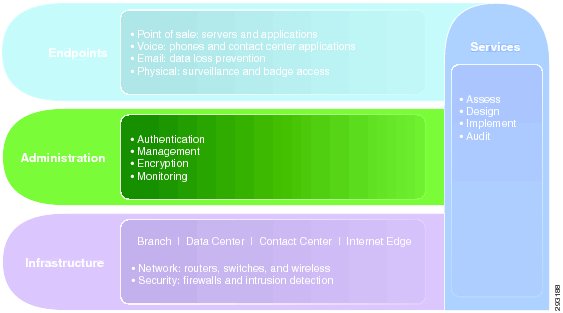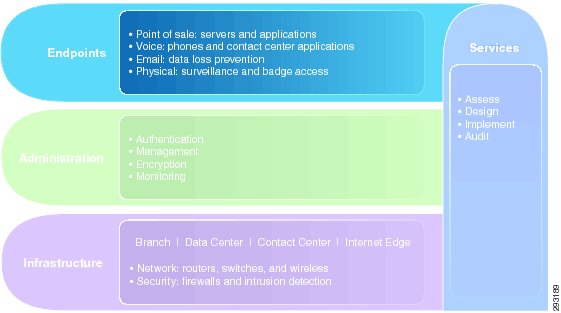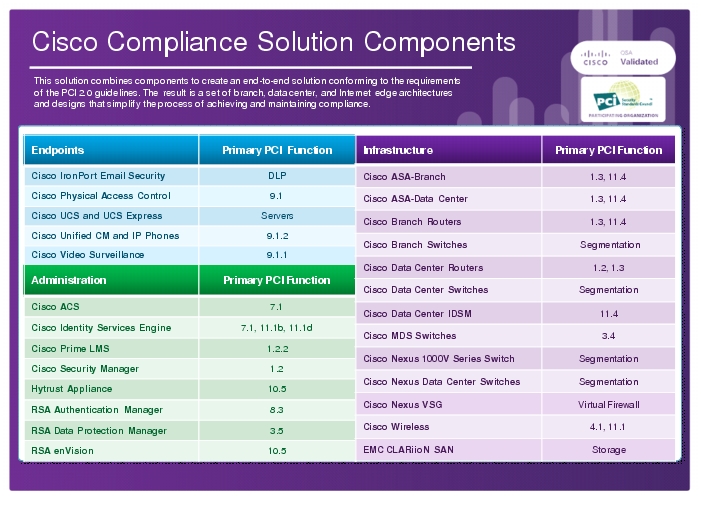

Table Of Contents
Small Branch—Convenience Design
Small Branch—Managed Service Provider Design
Solution Implementation
Overview
Cisco customers have asked Cisco to provide insight into how Cisco products can be used to address PCI DSS 2.0 requirements. To fully accomplish this goal, Cisco hired an auditor and went through the same process as organizations. To audit Cisco products for the capability to address compliance, they had to be installed and configured within a representative design.
This chapter demonstrates how the Cisco PCI solution was installed and configured to address the specifications of PCI 2.0. Cisco partnered with RSA, HyTrust, EMC, VCE, and Verizon Business to create a comprehensive design that reflected the framework and architectural principles discussed in earlier chapters.
The Cisco PCI solution was validated in the Cisco Lab in San Jose, California. The branches, data center, WAN, and Internet edge network infrastructures were built using Cisco best practice design guides, as represented by the Cisco enterprise architecture (http://www.cisco.com/go/designzone). The individual components were installed and configured to adhere to PCI 2.0 specifications. Verizon Business then conducted an assessment of the design and advised on remediation for specific configurations of individual components. After the remediation was complete, Verizon Business provided a detailed reference architecture report (see Appendix C, "Verizon Business Reference Architecture Report—Cisco PCI Solution.")
Tip
An architecture is a strategic structure for the consistent design, construction, and operation of systems to achieve a desired set of outcomes.
A design is a tactical implementation of an architectural strategy, using specific configurations of products to satisfy business requirements.
Chapter 3, "Solution Architecture," describes the enterprise architecture with regards to compliance. This chapter demonstrates a design or, in other words, a specific implementation of components to achieve these principles. Various designs can result from the solution architecture. The design that was implemented is not intended to represent the only way that Cisco and partner products can be installed to address PCI. It is intended to provide an example showing how and what was used to achieve the principles described in Chapter 3, "Solution Architecture."Although every company has specific considerations that vary from this implementation, these designs and the configurations of the components in "Detailed Full Running Configurations," provide an instructive example of what is needed to secure credit card data. Each component selected was audited for its capabilities, and that assessment is covered in the next chapter.
In each section, the reference architecture is shown with the corresponding design that was implemented and validated within the Cisco PCI laboratories. The full configurations of each individual component are available in "Detailed Full Running Configurations."
Infrastructure
The infrastructure layer of the solution framework addresses the components such as routers, switches, firewalls, and security components, as shown in Figure 4-1.
Figure 4-1 Infrastructure Layer of the Solution Framework
The following sections describe the designs that were implemented from the reference architecture.
Figure 4-2 shows the enterprise-wide reference architecture.
Figure 4-2 Enterprise-Wide Reference Architecture
Referencing the enterprise-wide architecture shown in Figure 4-2, the design shown in Figure 4-3 was created in the Cisco Lab.
Figure 4-3 Cisco PCI Solution Lab Architecture
Note the following:
•
Six branch designs were selected to represent Cisco and partner products.
•
The data center consists of a single aggregation block based on the Data Center 3.0 architecture.
•
The Internet edge is representative of both the e-commerce and partner edge for the purposes of validation.
The following sections describe this enterprise-wide design in more detail, and demonstrate what was implemented within the lab.
Branches
Multiple branch footprints were implemented that address a variety of business objectives. Each branch footprint section contains designs that were extracted from the reference architecture. Each design contains the following:
•
Reference architecture
•
Branch design
–
Logical topology
–
Addressing plan
–
Components selected
For component compliance functionality, see Chapter 5, "Component Assessment.". For full device configurations, see "Detailed Full Running Configurations."
Note
Each of these branch designs includes a variety of components that can be interchangeably used between them, depending on business requirements. For validation purposes, it was not necessary to implement all possible components in each design.
Small Branch Architecture
The small branch network scenario, shown in Figure 4-4, meets the following design requirements:
•
Branch size averages between 2000-6000 square feet
•
Fewer than 25 devices requiring network connectivity
•
Single router with firewall/IPS, integrated Ethernet switch, compact switch, and power-over-Ethernet (PoE)
•
Preference for integrated services within fewer network components because of physical space requirements
•
Wireless connectivity
Figure 4-4 Small Branch Architecture
The small branch reference architecture is a powerful platform for running an enterprise that requires simplicity and a compact form factor. This combination appeals to many formats that can include the following:
•
Small branch—Specialty shops, discount businesses
•
Mini branches—Fuel stations, mall outlet
•
Convenience branches—Pop-up stores, health centers, mall kiosks
•
Managed service provider branch—WAN access controlled by service provider
This network architecture is widely used and consolidates many services into fewer infrastructure components. The small branch also supports a variety of business application models because an integrated Ethernet switch supports high-speed LAN services. In addition, an integrated content engine supports centralized application optimization requirements such as Web Cache Communications Protocol (WCCP)-based caching, pre-positioning of data, local media streaming, and other application velocity services.
Advantages include the following:
•
Lower cost per branch
•
Fewer parts to spare
•
Fewer software images to maintain
•
Lower equipment maintenance costs
Limitations include the following:
•
Decreased levels of network resilience
•
Greater potential downtime because of single points of failure
Small Branch—Small Design
Figure 4-5 shows the small branch network design.
Figure 4-5 Small Branch Network Design
Components Selected
•
Cisco 2921 Integrated Services Router (ISR)
•
Cisco Catalyst 2960S 48-port PoE Switch
•
Cisco Aironet 3502i Access Points
•
Cisco Video Surveillance 4500 Series IP Cameras
•
Cisco Physical Access Gateway
Small Branch—Mini Design
The mini branch represents an alternate design for the small branch architecture, using different components.
Figure 4-6 shows the mini branch network design.
Figure 4-6 Mini Branch Network Design
Components Selected
•
Cisco 1941 Integrated Services Router (ISR)
•
Cisco Catalyst 2960 Switch
•
Cisco Aironet 3502e Access Point
Small Branch—Convenience Design
The convenience branch represents an alternate design for the small branch architecture. Figure 4-7 shows the convenience branch network design.
Figure 4-7 Convenience Branch Network Design
Components Selected
•
Cisco 891 Series Integrated Services Router (ISR)
•
Cisco Catalyst 2960 Series Switch
•
Cisco Aironet 1042N Access Point
Small Branch—Managed Service Provider Design
The managed service provider branch represents an alternate design for the small branch architecture. Figure 4-8 shows the managed service provider network design.
Figure 4-8 Managed Service Provider Branch Network Design
Components Selected
•
Cisco ASA 5510 Firewall with SSM-10
•
Cisco Catalyst 3560E Switch
•
Cisco Aironet 3502e Access Points
Medium Branch Architecture
The medium branch network scenario, shown in Figure 4-9, meets the following design requirements:
•
Branch size averages between 6,000-18,000 square feet
•
The physical size of the branch is smaller than a large branch, so a distribution layer of network switches is not required
•
Number of devices connecting to the network averages 25-100 devices
•
Redundant LAN and WAN infrastructures with firewall/IPS
•
Wireless connectivity
Figure 4-9 Medium Branch Architecture
The medium branch reference architecture is designed for enterprise businesses that require network resilience and increased levels of application availability over the small branch architecture and its single-threaded, simple approach. As more mission-critical applications and services converge onto the IP infrastructure, network uptime and application availability are more important. The dual-router and dual-LAN switch design of the medium branch supports these requirements. Each of the Cisco ISR routers can run Cisco IOS Software security services and other branch communication services simultaneously. Each of the Cisco ISR routers is connected to a dedicated WAN connection. Hot Standby Routing Protocol (HSRP) is used to ensure network resilience in the event that the network connection fails.
The access layer of the network offers enhanced levels of flexibility and more access ports compared to the small branch. Up to 12 wireless access points can be installed in the branch, supported by the Cisco Wireless Control System (WCS) controller as tested and without adding more controllers. The distributed Cisco Catalyst switches can support a combination of larger physical buildings or a larger number of endpoints than the small branch.
Advantages include the following:
•
More adaptive access layer with support for a greater number of endpoints and more diverse building requirements (multiple floors, sub-areas, and so on)
•
Improved network resilience through parallel device design
•
Improved network and application availability through parallel paths
Limitations include the following:
•
No distribution layer between core layer (the ISR) and the access layer switches
•
Single WCS Controller decreases in-branch resilience of the wireless network; the recommendation is to have branch APs fallback to the central WCS controller if the local WCS controller fails, or to install dual-local WCS controllers.
Medium Branch—Design
Figure 4-10 shows the medium branch network design.
Figure 4-10 Medium Branch Network Design
Components Selected
•
Cisco 2951 Integrated Services Router (ISR)
•
Cisco Catalyst 3750X 48-port PoE Switch
•
Cisco Catalyst 2960 Compact Switch
•
Cisco Aironet 3502e and 1262N Access Points
•
Cisco Video Surveillance 2421 IP Dome Camera
•
Cisco Video Surveillance 2500 Series IP Camera
•
Cisco Operations Manager v4.1
•
Cisco Physical Access Gateway
Large Branch Architecture
The large branch network scenario, shown in Figure 4-11, meets the following design requirements:
•
Branch size averages between 15,000-150,000 square feet
•
More than 100 devices per branch requiring network connectivity
•
Multiple routers with firewall/IPS for primary and backup network requirements
•
Preference for a combination of network services distributed within the branch to meet resilience and application availability requirements
•
Tiered network architecture within the branch; distribution layer switches are employed between the central network services core and the access layer connecting to the network endpoints (POS, wireless APs, servers)
Figure 4-11 Large Branch Architecture
The large branch reference architecture takes some of the elements of Cisco campus network architecture recommendations and adapts them to a large branch environment. Network traffic can be better segmented (logically and physically) to meet business requirements. The distribution layer of the large branch architecture can greatly improve LAN performance while offering enhanced physical media connections (that is, fiber and copper for connection to remote access layer switches and wireless access points). A larger number of endpoints can be added to the network to meet business requirements. This type of architecture is widely used by large format organizations globally. Dual routers and distribution layer media flexibility greatly improve network serviceability because the network is highly available and scales to support the large branch requirements. Routine maintenance and upgrades can be scheduled and performed more frequently or during normal business hours because of parallel path design.
Advantages include the following:
•
Highest network resilience based on highly available design
•
Port density and fiber density for large locations
•
Increase segmentation of traffic
•
Scalable to accommodate shifting requirements in large branches
Limitations include the following:
•
Higher cost because of network resilience based on highly available design
•
These branch network designs are capable of helping an organization achieve PCI compliance, and also serve as the scalable platform for new services and applications
Large Branch Design
Figure 4-12 shows the large branch network design.
Figure 4-12 Large Branch Network Design
Components Selected
•
Cisco 3945 Integrated Services Router (ISR)
•
Cisco Catalyst 3560X and 4500 switches
•
Cisco Aironet 3502e and 3502i Access Points
•
Cisco 5508 Wireless Controller
•
Cisco 4500 Video Surveillance Camera
•
Cisco Physical Access Gateway
Data Center
The data center is where centralized data processing, data storage, and data communications take place (see Figure 4-13). The data center is also the place where management systems are deployed. The data center provides centralized control from an administrative perspective because it is typically where the tools that are used to monitor and enforce compliance are deployed.
Figure 4-13 Data Center Architecture
Design considerations are as follows:
•
Centralized solution management supports all aspects of network, security, and systems management; and supports remote access from anywhere on the network.
•
Standardized equipment and software images, deployed in a modular, layered approach, simplify configuration management and increase the systems availability.
•
The highly available data center design permits highly resilient access from branches to core data and storage services.
•
WAN aggregation alternatives allow flexible selection of service provider network offerings.
•
The service aggregation design allows for a modular approach to adding new access layers and managing shared network services (for example, firewall, IPS, application networking, wireless management)
•
Firewall, IPS, and application networking services are available at the service and aggregation layers of the data center.
•
Scalability to accommodate shifting requirements in data center compute and storage requirements.
•
WAN access speeds are typically the limiting factor between the branch network systems and the WAN aggregation layer.
•
It is typical for organizations to over-subscribe the WAN circuits between the branches and the WAN edge aggregation router. Over-subscription can cause inconsistent results and packet loss of payment card information in the event that more traffic enters the WAN circuit simultaneously.
•
Backup network connections from branch networks to the data center are recommended when payment card information is transported via the WAN.
Figure 4-14 shows the data center design.
Figure 4-14 Data Center Design
Data centers can house many types of functions and the term itself can encompass narrow and broad aspects. For the purposes of this guide, data centers include the following functions:
•
WAN aggregation layer—Aggregates the branch and backstage WAN connections to the core
•
Core layer—Highly available, high-speed area that is the central point of connectivity to all data center areas
•
Aggregation block—Aggregates the services of one area and connects that area to the core, including Vblock1 design
•
Internet edge—Secure connectivity to the Internet
WAN Aggregation Layer Design
Figure 4-15 shows the WAN aggregation layer design.
Figure 4-15 WAN Aggregation Layer Design
Components Selected
•
Cisco ASR 1002-Fixed Router
•
Cisco ASA 5540 Adaptive Security Appliance
•
Cisco Catalyst 3750X Switch
Core Layer Design
Figure 4-16 shows the core layer design.
Figure 4-16 Core Layer Design
Components Selected
•
Cisco Catalyst 6500-E Switch
Aggregation Block Design
Figure 4-17 shows the aggregation block design.
Figure 4-17 Aggregation Block Design
Components Selected
•
Cisco ASA 5585-X Adaptive Security Appliance
•
Cisco Nexus 7010 Switch
•
Cisco Catalyst 6500-E Switch
–
Cisco ACE 20
–
Cisco IDSM-2
•
Cisco Nexus 5020 Switch
•
Cisco Catalyst 4948 Switch
Vblock Design
Figure 4-18 shows the Vblock design.
Figure 4-18 Vblock Design
Components Selected
•
Cisco UCS 5108 Blade Server Chassis
–
Cisco UCS B200 Blade Server
•
Cisco UCS 6120 Fabric Interconnect
•
Cisco MDS 9506 Multilayer Director
•
EMC CLARiion CX4 Model 240
Internet Edge Design
Figure 4-19 shows the Internet edge network design.
Figure 4-19 Internet Edge Network Design
Components Selected
•
Cisco 7200 Series Router
•
Cisco Catalyst 6500-E Switch
–
Cisco ACE 20
–
Cisco IDSM-2
•
Cisco Catalyst 3750X Switch
•
Cisco MDS 9204i Switch
•
Cisco IronPort C670
Addressing and Routing Disclosure
PCI requirement 1.3.8 states that merchants must not disclose private addressing and routing information. An enterprise contains two segments:
•
Public—Where Internet services are hosted
•
Private—Where internal systems reside that are not directly accessible from outside the company
Both may be deployed internally within an enterprise data center or other PIN. The private information must be protected and not propagated out to untrusted parties.
In 2013, it is common for enterprises to deploy an IPv6 Internet presence by using the Server Load Balancing (SLB) to do protocol family translation; that is, when the SLB receives an IPv6 inbound connection from the Internet, the SLB translates this connection on the fly into an IPv4 connection to the real servers.
In this solution, PCI 1.3.8 was met because all the security pieces for IPv4 are also used for IPv6 connections. Moreover, the servers where the information resides have no IPv6 addresses and cannot be reached over IPv6. The attack surface of the servers is strictly the IPv4 attack surface.
Note
For more information on the Cisco ACE Application Control Engine Module, see the following URL: http://www.cisco.com/en/US/products/ps6906/index.html.
A best practice when implementing IPv6 is a phased approach. Figure 4-20 illustrates the scenario described above as the first phase of an IPv6 deployment.
Figure 4-20 IPv6 Phased Approach
Administration
The administration layer of the solution framework addresses the components such as authentication, encryption, management, and monitoring, as shown in Figure 4-21.
Figure 4-21 Administration Layer of the Solution Framework
Authentication
Components Selected
•
Cisco Secure Access Control Server (ACS)
•
Cisco Identity Services Engine (ISE)
•
RSA Authentication Manager
•
Windows Active Directory
Encryption
Components Selected
•
Cisco Security Manager
•
Cisco Key Manager
•
RSA Data Protection Manager
Management
Components Selected
•
Cisco Prime LAN Management Solution (LMS)
•
Cisco Security Manager
•
Cisco Wireless Control Server Manager
•
EMC Unified Infrastructure Manager
•
VMware vSphere vCenter
•
Cisco Video Surveillance Manager
•
Cisco Physical Access Manager
•
RSA Archer
Monitoring
Components Selected
•
RSA enVision
•
HyTrust
Endpoints
The endpoints layer of the solution framework addresses the components such as voice, e-mail, and physical security, as shown in Figure 4-22.
Figure 4-22 Endpoints Layer of the PCI Solution Framework
Voice
Components Selected
•
Cisco Unified Communications Manager
•
Cisco IP Phones (9971, 7975)
•
Cisco Survivable Remote Site Telephony (SRST)
Components Selected
•
Cisco IronPort Email Security Appliance with Data Loss Prevention
•
Microsoft Exchange Server 2008
Physical
Components Selected
•
Cisco Physical Access Gateway
•
Cisco Video Surveillance Cameras (2421, 2500, 4500)
Note
For a complete Bill of Materials, see "Bill Of Material." For assessment of components selected for PCI compliance, see Chapter 5, "Component Assessment." For complete running configurations of components, see "Detailed Full Running Configurations."
PCI Solution Result Summary


